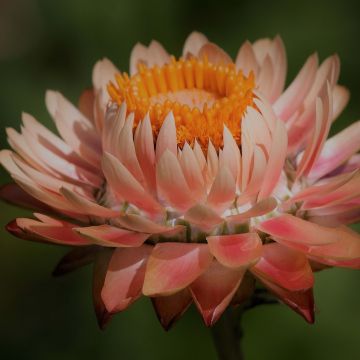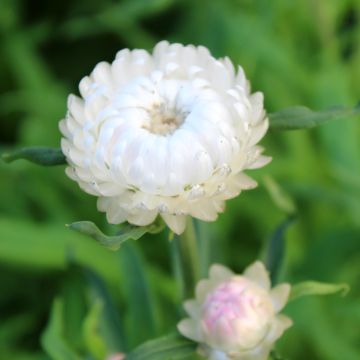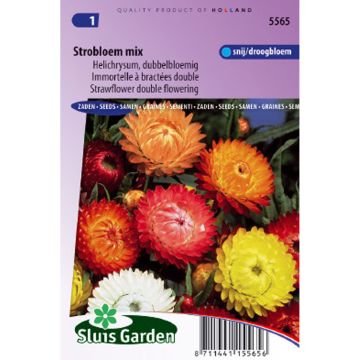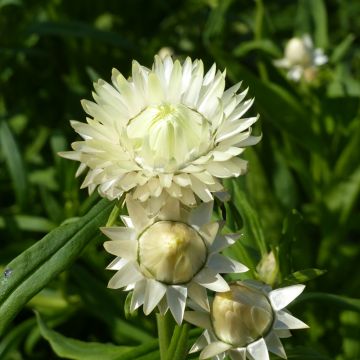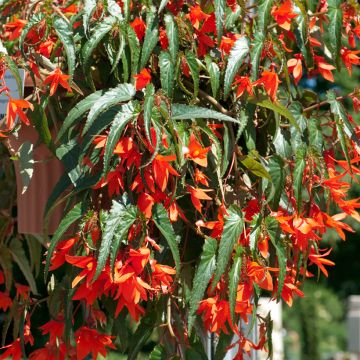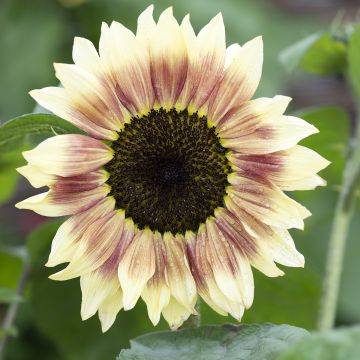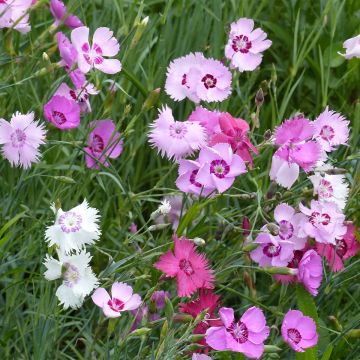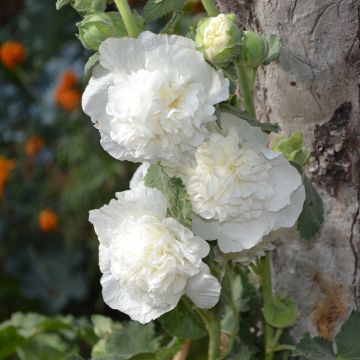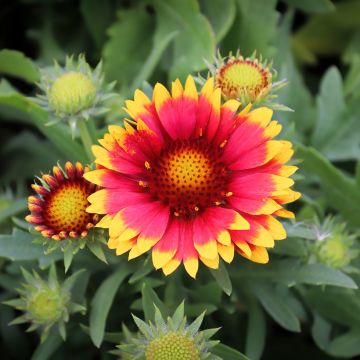

Helichrysum bracteatum Silvery Rose - Strawflower seeds
Helichrysum bracteatum Silvery Rose - Strawflower seeds
Helichrysum bracteatum King Size Silvery Rose
Strawflower, Everlasting flower
You can also sow directly in the ground in April or May, once the soil has warmed up enough and the frost has passed. Thin out your seedlings to keep only the most developed plants and maintain a distance of about 40 cm between each plant. Pinch the young plants to encourage branching and remove faded flowers as they appear.
Yeshua, 22/03/2024
Order in the next for dispatch today!
Dispatch by letter from €3.90.
Delivery charge from €5.90 Oversize package delivery charge from €6.90.
Current delivery delay: 1 day.
More information
This item is not available in your country.
Schedule delivery date,
and select date in basket
This plant carries a 6 months recovery warranty
More information
We guarantee the quality of our plants for a full growing cycle, and will replace at our expense any plant that fails to recover under normal climatic and planting conditions.
Seed-only orders are dispatched by sealed envelope. The delivery charge for seed-only orders is €3.90.
Does this plant fit my garden?
Set up your Plantfit profile →
Description
Helichrysum bracteatum Silvery Rose is distinguished by its large pink flowers with silvery reflections. Its heads, which never seem to fade, are perfect for making the lovely dried bouquets that are in fashion today. Everlasting flowers are appreciated for their long and generous summer flowering, as well as for their ease of cultivation. They like heat and sun and tolerate drought well. This annual, 80 cm tall plant, will find a place in a flowerbed, a border, or even in the vegetable garden. Sow under cover in March-April, or directly in the garden in April-May.
From the Asteraceae family, like sunflowers or daisies, Xerochrysum bracteatum is a perennial herbaceous plant native to Australia, grown as an annual in our latitudes. The everlasting flower is also known as Helichrysum bracteatum or Bracteantha bracteata. The Silvery Rose variety is covered from July to October with heads of approximately 4 cm in diameter. They consist of a yellow centre of fertile flowers surrounded by pink bracts with a cream-white reverse, giving them a silvery appearance. The bracts do not fade, making the everlasting flowers perfect for making dried flower bouquets. Harvest the flowers before they fully open and hang them upside down in a well-ventilated, dark place to dry. Then remove the leaves and let your creativity flow.
With their height of 80 cm, the King Size Silvery Rose Helichrysum will find its place in the vegetable garden, where traditionally cut flowers are planted, in a flowerbed or a border along with perennials or other annuals whose flowers can also be dried. Consider Achillea ptarmica Weihenstephan with lovely white flowers, the Rosy Veil Gypsophila with fluffy pink flowers, and the Flamingo Feather Cockscomb Celosia with mauve-pink flowers.
Report an error about the product description
Flowering
Foliage
Plant habit
Botanical data
Helichrysum
bracteatum
King Size Silvery Rose
Asteraceae
Strawflower, Everlasting flower
Cultivar or hybrid
Other Graines d'Immortelles
Planting and care
The Silvery Rose everlasting flower can be sown in March-April, either under a frame or in a pot indoors. The ideal germination temperature is 18 to 20 °C. Sow your seeds in a mixture of garden soil and compost. Germination can take between 15 and 20 days. Once the seedlings are strong enough, transplant them into pots and plant them in the garden once the risk of frost has passed, with a spacing of 35 to 40 cm.
You can also sow directly in the ground in April or May, once the soil has warmed up and the frost has passed. Thin out your seedlings to keep only the most developed plants and maintain a distance of about 40 cm between each plant.
Pinch the young plants to encourage branching and remove faded flowers as they appear.
Helichrysum bracteatum plants appreciate warmth and sunny, or slightly shaded, positions. They grow best in rich, neutral, light, and well-draining soil. They tolerate drought, although regular watering during flowering helps to obtain more developed plants. They also tolerate poor soils or partial shade, but they will be less floriferous.
Sowing period
Intended location
-
, onOrder confirmed
Reply from on Promesse de fleurs
Flower seeds
Haven't found what you were looking for?
Hardiness is the lowest winter temperature a plant can endure without suffering serious damage or even dying. However, hardiness is affected by location (a sheltered area, such as a patio), protection (winter cover) and soil type (hardiness is improved by well-drained soil).

Photo Sharing Terms & Conditions
In order to encourage gardeners to interact and share their experiences, Promesse de fleurs offers various media enabling content to be uploaded onto its Site - in particular via the ‘Photo sharing’ module.
The User agrees to refrain from:
- Posting any content that is illegal, prejudicial, insulting, racist, inciteful to hatred, revisionist, contrary to public decency, that infringes on privacy or on the privacy rights of third parties, in particular the publicity rights of persons and goods, intellectual property rights, or the right to privacy.
- Submitting content on behalf of a third party;
- Impersonate the identity of a third party and/or publish any personal information about a third party;
In general, the User undertakes to refrain from any unethical behaviour.
All Content (in particular text, comments, files, images, photos, videos, creative works, etc.), which may be subject to property or intellectual property rights, image or other private rights, shall remain the property of the User, subject to the limited rights granted by the terms of the licence granted by Promesse de fleurs as stated below. Users are at liberty to publish or not to publish such Content on the Site, notably via the ‘Photo Sharing’ facility, and accept that this Content shall be made public and freely accessible, notably on the Internet.
Users further acknowledge, undertake to have ,and guarantee that they hold all necessary rights and permissions to publish such material on the Site, in particular with regard to the legislation in force pertaining to any privacy, property, intellectual property, image, or contractual rights, or rights of any other nature. By publishing such Content on the Site, Users acknowledge accepting full liability as publishers of the Content within the meaning of the law, and grant Promesse de fleurs, free of charge, an inclusive, worldwide licence for the said Content for the entire duration of its publication, including all reproduction, representation, up/downloading, displaying, performing, transmission, and storage rights.
Users also grant permission for their name to be linked to the Content and accept that this link may not always be made available.
By engaging in posting material, Users consent to their Content becoming automatically accessible on the Internet, in particular on other sites and/or blogs and/or web pages of the Promesse de fleurs site, including in particular social pages and the Promesse de fleurs catalogue.
Users may secure the removal of entrusted content free of charge by issuing a simple request via our contact form.
The flowering period indicated on our website applies to countries and regions located in USDA zone 8 (France, the United Kingdom, Ireland, the Netherlands, etc.)
It will vary according to where you live:
- In zones 9 to 10 (Italy, Spain, Greece, etc.), flowering will occur about 2 to 4 weeks earlier.
- In zones 6 to 7 (Germany, Poland, Slovenia, and lower mountainous regions), flowering will be delayed by 2 to 3 weeks.
- In zone 5 (Central Europe, Scandinavia), blooming will be delayed by 3 to 5 weeks.
In temperate climates, pruning of spring-flowering shrubs (forsythia, spireas, etc.) should be done just after flowering.
Pruning of summer-flowering shrubs (Indian Lilac, Perovskia, etc.) can be done in winter or spring.
In cold regions as well as with frost-sensitive plants, avoid pruning too early when severe frosts may still occur.
The planting period indicated on our website applies to countries and regions located in USDA zone 8 (France, United Kingdom, Ireland, Netherlands).
It will vary according to where you live:
- In Mediterranean zones (Marseille, Madrid, Milan, etc.), autumn and winter are the best planting periods.
- In continental zones (Strasbourg, Munich, Vienna, etc.), delay planting by 2 to 3 weeks in spring and bring it forward by 2 to 4 weeks in autumn.
- In mountainous regions (the Alps, Pyrenees, Carpathians, etc.), it is best to plant in late spring (May-June) or late summer (August-September).
The harvesting period indicated on our website applies to countries and regions in USDA zone 8 (France, England, Ireland, the Netherlands).
In colder areas (Scandinavia, Poland, Austria...) fruit and vegetable harvests are likely to be delayed by 3-4 weeks.
In warmer areas (Italy, Spain, Greece, etc.), harvesting will probably take place earlier, depending on weather conditions.
The sowing periods indicated on our website apply to countries and regions within USDA Zone 8 (France, UK, Ireland, Netherlands).
In colder areas (Scandinavia, Poland, Austria...), delay any outdoor sowing by 3-4 weeks, or sow under glass.
In warmer climes (Italy, Spain, Greece, etc.), bring outdoor sowing forward by a few weeks.



































